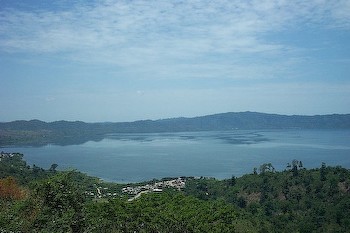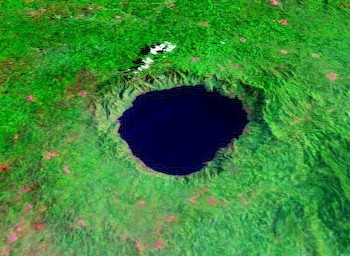|
 Lake
Bosumtwi, situated within an ancient meteorite impact crater, is
approximately 8 km across and the only natural lake in Ghana. It is situated
about 30 km south-east of Kumasi and is a popular recreational area. There
are about 30 villages near the lake, with a combined population of about
70,000 people. The Ashanti consider Bosumtwi a sacred lake. According to
traditional belief, the souls of the dead come here to bid farewell to the
god Twi. Because of this, it is considered permissible to fish in the lake
only from wooden planks. Lake
Bosumtwi, situated within an ancient meteorite impact crater, is
approximately 8 km across and the only natural lake in Ghana. It is situated
about 30 km south-east of Kumasi and is a popular recreational area. There
are about 30 villages near the lake, with a combined population of about
70,000 people. The Ashanti consider Bosumtwi a sacred lake. According to
traditional belief, the souls of the dead come here to bid farewell to the
god Twi. Because of this, it is considered permissible to fish in the lake
only from wooden planks.
The Lake Bosumtwi impact crater is 10.5
km in diameter, slightly larger than the present lake, and is estimated to
be 1.07 million years old (Pleistocene period).
The crater has been partly eroded, and is situated in dense rainforest,
making it difficult to study and confirm its origin by meteorite impact.
Shock features such as shatter cones are largely overgrown by vegetation or
covered by the lake. However, drilling of the crater's central uplift
beneath the lake floor has recently provided an abundance of shocked
materials for scientific study. Tektites, believed to be from this impact,
are found in the neighbouring country of Ivory Coast, and related
microtektites have been found in deep sea sediments west of the African
continent.
 Before the asteroid
hit, there was a lush rainforest filled with animals. The crater from the
asteroid's impact filled with rainwater, so now there is a lake. Periods of
heavy rainfall filled the crater with water, causing the lake level to rise
above the lowest points of the rim. Such periods are evidenced from fossils
of fish found on hilltops. Water even flowed from the basin through an
overflow channel. However, there were also times when the water level was so
low that the rainforest entered the basin rendering the lake only a small
pond. Such a period, according to legend and now proved by paleoclimate
records, lasted until about 300 years ago (Shanahan et al. 2009). Lake
Bosumtwi can be used to argue that the drought over sub-Saharan Africa and
the Sahel during the late 1970s orgininated from that of natural variability
forced by a multidecadal oscillation in the thermohaline circulation, which
in turn modulates sea surface temperature in the north Atlantic. This
evidence shows the drought occurred via natural origins instead of
anthropogenic forcing. It has been shown that historical droughts in this
region were four times drier than that of the late 1970s drought. Before the asteroid
hit, there was a lush rainforest filled with animals. The crater from the
asteroid's impact filled with rainwater, so now there is a lake. Periods of
heavy rainfall filled the crater with water, causing the lake level to rise
above the lowest points of the rim. Such periods are evidenced from fossils
of fish found on hilltops. Water even flowed from the basin through an
overflow channel. However, there were also times when the water level was so
low that the rainforest entered the basin rendering the lake only a small
pond. Such a period, according to legend and now proved by paleoclimate
records, lasted until about 300 years ago (Shanahan et al. 2009). Lake
Bosumtwi can be used to argue that the drought over sub-Saharan Africa and
the Sahel during the late 1970s orgininated from that of natural variability
forced by a multidecadal oscillation in the thermohaline circulation, which
in turn modulates sea surface temperature in the north Atlantic. This
evidence shows the drought occurred via natural origins instead of
anthropogenic forcing. It has been shown that historical droughts in this
region were four times drier than that of the late 1970s drought.
 The legends say that in 1648 an Ashanti
hunter named Akora Bompe from the city of Asaman was chasing an injured
antelope through the rainforest. Suddenly, the animal disappeared in a small
pond. It was as if this body of water wanted to save the animal's life. The
hunter never got the antelope, though he settled close to the water and
started catching fish. This place he named “Bosomtwe”, meaning “antelope
god”. This story suggests that at that time the lake level was very low. The
large dead trees standing offshore in the lake also evidence this, for they
are over 300 years old. The following centuries saw several wars about the
lake as both the Ashanti and the Akim clashed, each claiming the area. The
Ashanti prevailed. The legends say that in 1648 an Ashanti
hunter named Akora Bompe from the city of Asaman was chasing an injured
antelope through the rainforest. Suddenly, the animal disappeared in a small
pond. It was as if this body of water wanted to save the animal's life. The
hunter never got the antelope, though he settled close to the water and
started catching fish. This place he named “Bosomtwe”, meaning “antelope
god”. This story suggests that at that time the lake level was very low. The
large dead trees standing offshore in the lake also evidence this, for they
are over 300 years old. The following centuries saw several wars about the
lake as both the Ashanti and the Akim clashed, each claiming the area. The
Ashanti prevailed.
Each village in the lake area has its own shrine or fetish grove. With the
arrival of Christianity, some of people gave up former beliefs, though many
continue to seek traditional help in bad times or against diseases. The
Abrodwum Stone is held to be the spiritual centre of the lake. Here, when
there is such poor fishing it is considered a bad omen, the lake people
sacrifice a cow. This act is celebrated in the presence of his majesty, the
Ashanti king, the Asantehene himself. In the ceremony, the cow's innards are
given to the stone and the rest is thrown into the lake. The crowd rushes
into the water with cutlasses and axes to take their share of the meat. This
is an event very much worth seeing. However, as such an omen depends on
various factors, it is hardly predictable.
There is a traditional taboo against touching the water with iron and modern
boats are not considered appropriate. The padua, a wooden plank requiring
considerable skill to maneuver, is the legitimate method. There are current
environmental concerns, including overfishing and inadequate farming
methods. The growing population increased demand for fish. Excessive fishing
led to steadily decreasing catches, forcing increased reliance on
agriculture. As more and more of the hills are converted into farmland,
exposing the surface to the heavy rainfalls, soil erosion becomes an ever
greater problem. In addition there is the changing lake level. Many villages
have been submerged several times forcing the people to move up the slopes
or outside the basin. That is the origin of such double names as Pipie No.1
and Pipie No.2 .
The lake is a popular resort area with local people for swimming, fishing
and boat trips. The lakeside village of Amakom has a small hospital with a
doctor residing on premise, called Lake Bosumtwi Methodist Clinic, providing
emergency services by boat and 4x4 ambulance.
|